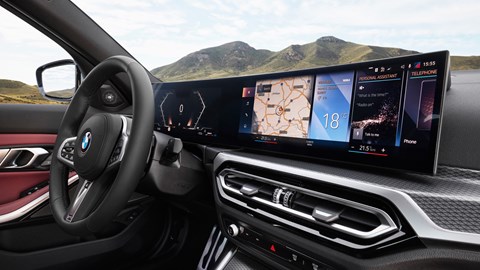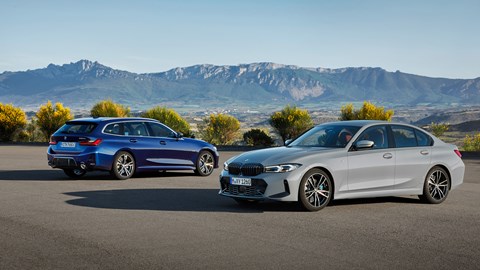► Redesigned front end with slimmer headlights
► Updated interior with new infotainment system
► On sale now, priced from £36,670
This is the facelifted BMW 3 Series. It features a range of cosmetic and technological tweaks inside and out that are designed to keep the car competitive in the ever-changing compact executive class. It’s available to order now, with prices starting from £36,670 for the saloon and £39,810 for the estate.
Traditionally, the BMW 3 Series has only really needed to compete with Teutonic rivals such as the Mercedes C-Class and Audi A4. These days, though, the saloon has rivals coming at it from all angles, with cars like the Alfa Romeo Giulia, Kia Stinger and pure-electric Tesla Model 3 all vying for a piece of the pie. So this update is an important one.
What’s changed, then?
Quite a bit, actually. BMW used the same styling language for the revised 3 Series as it did with the facelifted 5 Series, fitting slimmer LED headlamps, a tweaked version of its trademark kidney grilles and a redesigned front bumper. The changes at the front are echoed at the rear by fresh tail lights and a new apron.
Adaptive LED headlights can be specified as an optional extra. They have a cornering function and a range of beam settings to suit different driving scenarios. For example, the motorway beam pattern has a longer dipped beam range, while the urban beam pattern is broader to give the driver a better view of pedestrians and cyclists.

BMW has launched some trim-specific changes for the 3 Series, too. M Sport models get a newly designed set of 18-inch alloy wheels, an updated rear diffuser and a redesigned front bumper with narrower side intakes and a new lower grille.
M Sport Pro cars (which sit above the M Sport variant in the 3 Series hierarchy) get some extra tweaks, such as red brake callipers, a spoiler for the bootlid, black chrome exhaust tips and a black kidney grille surround to replace the standard chrome unit on the M Sport model.
Finally, BMW has made some changes to the performance-focussed M340i and M340d models. They come with exclusive 19-inch alloy wheels, mesh kidney grilles, trapezoidal exhaust tips and gloss black mirror caps. Adaptive LED headlights are fitted as standard to both models. The facelifted BMW M3 will be unveiled at a later date.
What about the interior?
BMW has made some big changes here. The old car’s infotainment system has been junked in favour of the brand’s bang-up-to-date “Curved Display.” The system comprises a 12.3-inch digital gauge cluster and a 14.9-inch touchscreen – but they’re blended into one seamless unit that spans half the width of the dashboard.
The physical buttons for the climate controls have also been lost in the update, although drivers can still operate the screen using BMW’s iDrive rotary controller. It’s set into a new panel on the centre console that features a smaller toggle switch for the automatic gear selector, a touch-sensitive parking brake button and new drive mode controls.

BMW has also tweaked the 3 Series’s climate control system to suit the new infotainment setup. The air outlets below the screen are a little slimmer than before – and the company says the cabin temperature system can now be programmed using voice commands.
What about the engines?
For now, there are six powertrains to choose from. There are three petrols, two diesels and one plug-in hybrid – and every engine in the 3 Series line-up is mated to an eight-speed automatic gearbox. The petrol range opens with the 320i, which features a 2.0-litre four-cylinder unit with 181bhp and 221lb/ft of torque.
Above that, there’s the 330i. It uses a more powerful version of the same 2.0-litre engine which develops 254bhp and 295lb/ft of torque. BMW says that’s enough for a 0–62mph time of 5.9 seconds and a top speed of 155mph. Both the 320i and 330i feature rear-wheel drive as standard, although the former can be specified with four-wheel drive.

BMW has revised the 320d model, adding 48-volt mild-hybrid assistance in an effort to improve the engine’s efficiency. It’s based on the same 187bhp 2.0-litre four-cylinder unit as before, but the compact starter-generator can add an extra 11bhp of electrical assistance off the line. BMW claims the engine will deliver between 51.4–58.9mpg on the WLTP cycle.
If you live in an emissions-controlled area, it might be worth opting for the plug-in hybrid 330e. It adds an electric motor and a 12kWh battery pack to the 320i’s 2.0-litre four-cylinder petrol engine, boosting power to 288bhp and 310lb/ft of torque. CO2 emissions are as low as 30g/km, while fuel economy is claimed to be as high as 218mpg.

At the top of the current 3 Series line-up, there’s the M340i and the M340d. Both feature turbocharged 3.0-litre straight-six engines, but the former burns petrol, while the latter is powered by diesel. Both feature four-wheel drive as standard, both have a top speed of 155mph and both have a starting price of £52,965.
The M340i has an output of 369bhp and 369lb/ft of torque, which BMW says will propel the 3 Series from 0–62mph in 4.4 seconds. The M340d produces 335bhp and a stonking 516lb/ft of torque, which can push the saloon on the same 0–62mph sprint in 4.6 seconds.
Any other fancy technology that’s worth mentioning?
Silly question, really. It’s a BMW – of course there is. The brand’s Parking Assistant system is fitted as standard and can automatically steer the car into parallel and end-on spaces. The package also comes with a rear-view camera and BMW’s Reversing Assistant, which can automatically back the car up for distances of up to 50 metres.
Buyers can upgrade this package to Parking Assistant Plus. This adds a couple more functions for the reversing camera and a 360-degree camera, complete with a setting that allows the owner to view a live image of their car’s surroundings on their smartphone.
The autonomous revolution is coming – and BMW won’t be caught out by it. The 3 Series can be specified with a Level 2 semi-autonomous driving mode, which can take control of the car’s steering, brakes and throttle on the motorway under the driver’s supervision. The system can even take evasive action if it senses a hazard.
